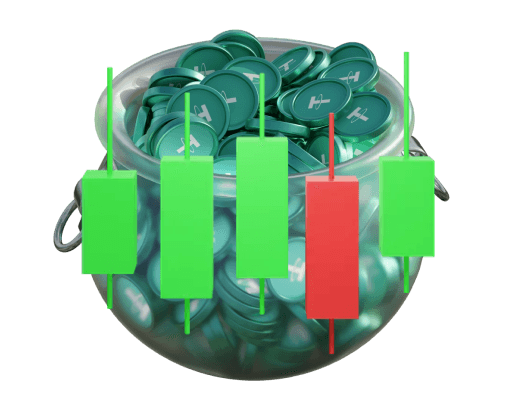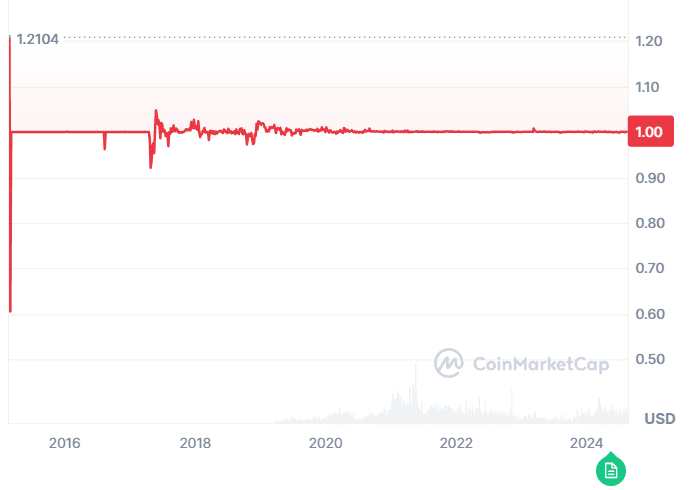USDT Price History:
Key Things to Know About Tether Price

Time to read: 8 min
USDT holds a unique place in cryptocurrency history as a pioneer among stablecoins. Since its launch in 2014, Tether has been notable for its concept of a digital token pegged 1:1 to the US dollar. This article explores Tether's history, examines instances of price fluctuation, and explains how it works to maintain its value.
What Is Tether (USDT)?
Launched in 2014 by Tether Limited, Tether (USDT) is a stablecoin designed to hold a value equivalent to the US dollar. The 1:1 peg is intended to minimize price volatility, making USDT a popular choice for trading, transferring funds, and hedging against market fluctuations.
The core principle of USDT is that each token is backed by reserves held by the issuing company. This backing is meant to ensure that the value of circulating tokens corresponds to the company's assets, providing stability.
History of Tether
Tether originated on the Bitcoin blockchain via the Omni Layer protocol. Initially named Realcoin, it was co-founded by Reeve Collins, Brock Pierce, and Craig Sellars. Their goal was to create a transparent and stable digital currency. By late 2014, the project was rebranded to Tether, and by 2015, USDT was listed on several major cryptocurrency exchanges.
Key Features of Tether
USDT is one of the world's most popular cryptocurrencies and is classified as a stablecoin.
- Pegged Value: As a stablecoin, USDT is designed to be pegged 1:1 to the US dollar to minimize price volatility.
- Asset Backing: Each token is backed by an equivalent value of assets held in reserve by Tether Limited.
- Primary Uses: USDT is widely used to transfer funds between exchanges, manage trading risks, and preserve value during market downturns.
- Blockchain Support: The token operates on multiple blockchains, including Ethereum, TRON, BNB Chain, and Avalanche.
- Issuance and Redemption: New USDT tokens are issued when users deposit dollars, and tokens are burned when users redeem them. USDT cannot be mined or staked.
- Audits and Transparency: Tether publishes regular reports on its reserves, though it has faced scrutiny regarding the composition and sufficiency of its backing.
Tether (USDT) Overview
USDT Price $1.00 Price Change 24h +0.01% Price Change 7d -0.01% Market Cap $112,800,000,000 Circulating Supply 112,800,000,000 Total Supply 116,100,000,000 Trading Volume 24h $51,872,162,857 All-Time High (ATH) $1.32 All-Time Low (ATL) $0.57
How Does Tether (USDT) Work?
Tether aims to maintain a 1:1 value ratio between USDT and the US dollar. The mechanism works by backing each issued token with assets held in reserve. For example, to support 100 USDT in circulation, the company should hold assets worth $100. If the market price of USDT deviates from $1, Tether can intervene by buying or selling assets to stabilize the price.
One USDT is not a literal US dollar but a token backed by Tether's reserves. According to Tether's Q1 2024 report, the company held over $113 billion in assets against approximately $104 billion in issued tokens, indicating its reserves exceeded the value of circulating USDT. The composition of these reserves has evolved and includes cash, cash equivalents, and other assets. The exact ratio and quality of reserves have been subjects of debate.
Tether (USDT) Chart

Key Tether Market Metrics
Understanding key market metrics is essential for evaluating any digital asset. By analyzing these indicators, investors can make more informed decisions.
Current Price
The USDT exchange rate consistently remains close to its $1.00 peg, showing minimal fluctuation over time.
Market Capitalization
USDT has the largest market capitalization among all stablecoins and consistently ranks as one of the top cryptocurrencies by this metric. Its market cap stands at approximately $112.8 billion.
Trading Volume
With a daily trading volume often exceeding $50 billion, USDT is one of the most liquid cryptocurrencies. This high volume indicates strong demand and makes it easy for traders to buy or sell large amounts without significantly impacting the price.
USDT Rate Fluctuations
While Tether is designed to maintain parity with the US dollar, its history includes several notable price fluctuations. Shortly after its launch in 2015, low liquidity caused significant volatility, with the price falling to an all-time low of approximately $0.57 and spiking to an all-time high of $1.32.
The price stabilized for a period but dropped to $0.91 in April 2017 amid banking issues. In October 2018, during a broader market crash, USDT's value temporarily fell to $0.95. Another dip to $0.94 occurred in May 2019 following news of an investigation into its sister company, Bitfinex. In each instance, the peg was eventually re-established, but these events highlight that perfect 1:1 parity is not always guaranteed.
Conclusion
Tether (USDT) plays a foundational role in the digital currency ecosystem as the leading stablecoin. While it has faced historical price fluctuations and scrutiny over its reserves, it remains one of the most widely used and liquid digital assets. Tether Limited continues to work on maintaining its peg and providing transparency, which are critical factors for retaining the trust of its global user base.
FAQ
Similar guides
What Is USDT:
A Complete Guide on Tether
Oct 23, 2025
USDT Price Prediction:
Tether Price Forecast
Oct 24, 2025
The Cheapest Way to Buy USDT:
How to Buy Tether
Sep 27, 2025

USDT holds a unique place in cryptocurrency history as a pioneer among stablecoins. Since its launch in 2014, Tether has been notable for its concept of a digital token pegged 1:1 to the US dollar. This article explores Tether's history, examines instances of price fluctuation, and explains how it works to maintain its value.
What Is Tether (USDT)?
Launched in 2014 by Tether Limited, Tether (USDT) is a stablecoin designed to hold a value equivalent to the US dollar. The 1:1 peg is intended to minimize price volatility, making USDT a popular choice for trading, transferring funds, and hedging against market fluctuations.
The core principle of USDT is that each token is backed by reserves held by the issuing company. This backing is meant to ensure that the value of circulating tokens corresponds to the company's assets, providing stability.
History of Tether
Tether originated on the Bitcoin blockchain via the Omni Layer protocol. Initially named Realcoin, it was co-founded by Reeve Collins, Brock Pierce, and Craig Sellars. Their goal was to create a transparent and stable digital currency. By late 2014, the project was rebranded to Tether, and by 2015, USDT was listed on several major cryptocurrency exchanges.
Key Features of Tether
USDT is one of the world's most popular cryptocurrencies and is classified as a stablecoin.
- Pegged Value: As a stablecoin, USDT is designed to be pegged 1:1 to the US dollar to minimize price volatility.
- Asset Backing: Each token is backed by an equivalent value of assets held in reserve by Tether Limited.
- Primary Uses: USDT is widely used to transfer funds between exchanges, manage trading risks, and preserve value during market downturns.
- Blockchain Support: The token operates on multiple blockchains, including Ethereum, TRON, BNB Chain, and Avalanche.
- Issuance and Redemption: New USDT tokens are issued when users deposit dollars, and tokens are burned when users redeem them. USDT cannot be mined or staked.
- Audits and Transparency: Tether publishes regular reports on its reserves, though it has faced scrutiny regarding the composition and sufficiency of its backing.
Tether (USDT) Overview
| USDT Price | $1.00 |
| Price Change 24h | +0.01% |
| Price Change 7d | -0.01% |
| Market Cap | $112,800,000,000 |
| Circulating Supply | 112,800,000,000 |
| Total Supply | 116,100,000,000 |
| Trading Volume 24h | $51,872,162,857 |
| All-Time High (ATH) | $1.32 |
| All-Time Low (ATL) | $0.57 |
How Does Tether (USDT) Work?
Tether aims to maintain a 1:1 value ratio between USDT and the US dollar. The mechanism works by backing each issued token with assets held in reserve. For example, to support 100 USDT in circulation, the company should hold assets worth $100. If the market price of USDT deviates from $1, Tether can intervene by buying or selling assets to stabilize the price.
One USDT is not a literal US dollar but a token backed by Tether's reserves. According to Tether's Q1 2024 report, the company held over $113 billion in assets against approximately $104 billion in issued tokens, indicating its reserves exceeded the value of circulating USDT. The composition of these reserves has evolved and includes cash, cash equivalents, and other assets. The exact ratio and quality of reserves have been subjects of debate.
Tether (USDT) Chart

Key Tether Market Metrics
Understanding key market metrics is essential for evaluating any digital asset. By analyzing these indicators, investors can make more informed decisions.
Current Price
The USDT exchange rate consistently remains close to its $1.00 peg, showing minimal fluctuation over time.
Market Capitalization
USDT has the largest market capitalization among all stablecoins and consistently ranks as one of the top cryptocurrencies by this metric. Its market cap stands at approximately $112.8 billion.
Trading Volume
With a daily trading volume often exceeding $50 billion, USDT is one of the most liquid cryptocurrencies. This high volume indicates strong demand and makes it easy for traders to buy or sell large amounts without significantly impacting the price.
USDT Rate Fluctuations
While Tether is designed to maintain parity with the US dollar, its history includes several notable price fluctuations. Shortly after its launch in 2015, low liquidity caused significant volatility, with the price falling to an all-time low of approximately $0.57 and spiking to an all-time high of $1.32.
The price stabilized for a period but dropped to $0.91 in April 2017 amid banking issues. In October 2018, during a broader market crash, USDT's value temporarily fell to $0.95. Another dip to $0.94 occurred in May 2019 following news of an investigation into its sister company, Bitfinex. In each instance, the peg was eventually re-established, but these events highlight that perfect 1:1 parity is not always guaranteed.
Conclusion
Tether (USDT) plays a foundational role in the digital currency ecosystem as the leading stablecoin. While it has faced historical price fluctuations and scrutiny over its reserves, it remains one of the most widely used and liquid digital assets. Tether Limited continues to work on maintaining its peg and providing transparency, which are critical factors for retaining the trust of its global user base.
